Charging Pile Equipment: Fast Charge vs. Standard Charge Explained
In an era where electric vehicles (EVs) are becoming increasingly popular, understanding the different types of charging pile equipment is essential for both EV owners and businesses in the electric vehicle sector. Among the various types of charging solutions available, fast charge and standard charge systems stand out. Each serves a specific purpose and comes with unique advantages. Let's delve into these two charging options to appreciate their differences and benefits.
If you are looking for more details, kindly visit charging pile equipment.
Understanding Charging Piles
Charging piles are essentially the equipment that supplies electricity for recharging electric vehicles. They can be found at homes, businesses, and public charging stations. The choice between fast charge and standard charge often depends on various factors, including the vehicle's battery capacity, the time available for charging, and user preferences.
What is Fast Charging?
Fast charging refers to the ability to recharge a vehicle's battery significantly quicker than traditional methods. Typically, these stations can replenish 80% of an EV's battery in about 30 minutes. Fast charging systems, often utilizing DC (Direct Current), deliver higher power levels making them suitable for quick top-ups, especially useful during long trips.
Benefits of Fast Charging
Time Efficiency: One of the most significant advantages of fast charging is the reduced time spent at charging stations. For busy individuals, this means less waiting and more driving.
Convenience: Fast chargers are often strategically placed along highways and popular routes, making them ideal for long-distance travel.
Increased Utilization: Businesses offering fast charging solutions can attract more EV users, promoting a sustainable model while boosting their customer base.
What is Standard Charging?
In contrast, standard charging refers to the traditional method of recharging an electric vehicle's battery, usually delivered via Level 2 charging stations. These systems often utilize AC (Alternating Current) and typically take several hours to provide a complete charge—generally between four to eight hours, depending on the vehicle and charging equipment.
See also:Streamline Your Calcium Silicate Board Production: Key Insights
Is Mustard Oil Expeller Machine Worth the Investment?
Benefits of Standard Charging
7 Key Benefits of Using a Maize Roller Mill for Your Business
Dough Rounder Machines: Top Picks for 2025 Success
How to Optimize Your Fully Automatic Lithium Ion Battery Assembly Line?
Billet and Bar Induction Forging Machine: A Simple Guide
7 Essential Steps for a Successful Maize Flour Processing Plant ServiceCost-Effectiveness: Standard charging stations are usually less expensive to install and maintain than fast charging stations. They are a practical choice for residential areas and workplaces.
Suitable for Overnight Charging: Many EV owners plug in their vehicles at night, allowing them to fully charge while they sleep without the need for rapid replenishments.
Battery Longevity: Charging at a slower rate can potentially increase battery lifespan. Rapid charging generates more heat, which may contribute to quicker battery degradation over time.
Comparing Fast Charge and Standard Charge
While both fast and standard charging systems cater to electric vehicle owners, they serve different needs and circumstances. Here’s a quick comparison:
| Feature | Fast Charging | Standard Charging |
|---|---|---|
| Charging Time | 30 minutes for 80% | 4 to 8 hours for full charge |
| Power Type | DC (Direct Current) | AC (Alternating Current) |
| Installation Cost | Higher | Lower |
| Best Use Case | Long trips, quick top-ups | Overnight or home charging |
| Impact on Battery Life | Potentially less favorable | More favorable |
Making the Right Choice
When deciding between fast charge and standard charge options, several factors come into play. For instance, if you are an EV owner who frequently travels long distances, investing in fast charging capabilities may be worth it. On the other hand, if you mainly use your vehicle for local commuting, a standard charging option could be perfectly adequate.
Business owners also need to consider their client base. Offering both types of charging solutions can cater to a broader audience and meet the varying needs of electric vehicle users.
Conclusion
In summary, the distinction between fast charging and standard charging is significant in the context of electric vehicle ownership. Understanding each option can lead to more informed choices, whether you are an individual EV owner or a business considering charging infrastructure. As electric vehicles become a staple on our roads, the evolution of charging technology will continue to play a pivotal role in shaping the future of transportation. Embrace the change, and you could find that charging your EV is not just convenient but also a stepping stone towards a greener planet.
For more 6.5 ton wheel loader manufacturerinformation, please contact us. We will provide professional answers.
See also:Reliable 280 kW Perkins Generator: Features and Benefits
Is a High-End Rotary Heat Press Worth the Investment for Your Work?
Benefits of Beginner Rotary Fabric Press for New Users
Is Automation Diminishing Artisan Bread Quality?
Are Your Laser Welding Machines Causing Battery Quality Issues?
How is technology reshaping maize processing efficiency?
Understanding Rotary Drilling Rigs: Types, Uses, and Benefits Explained





